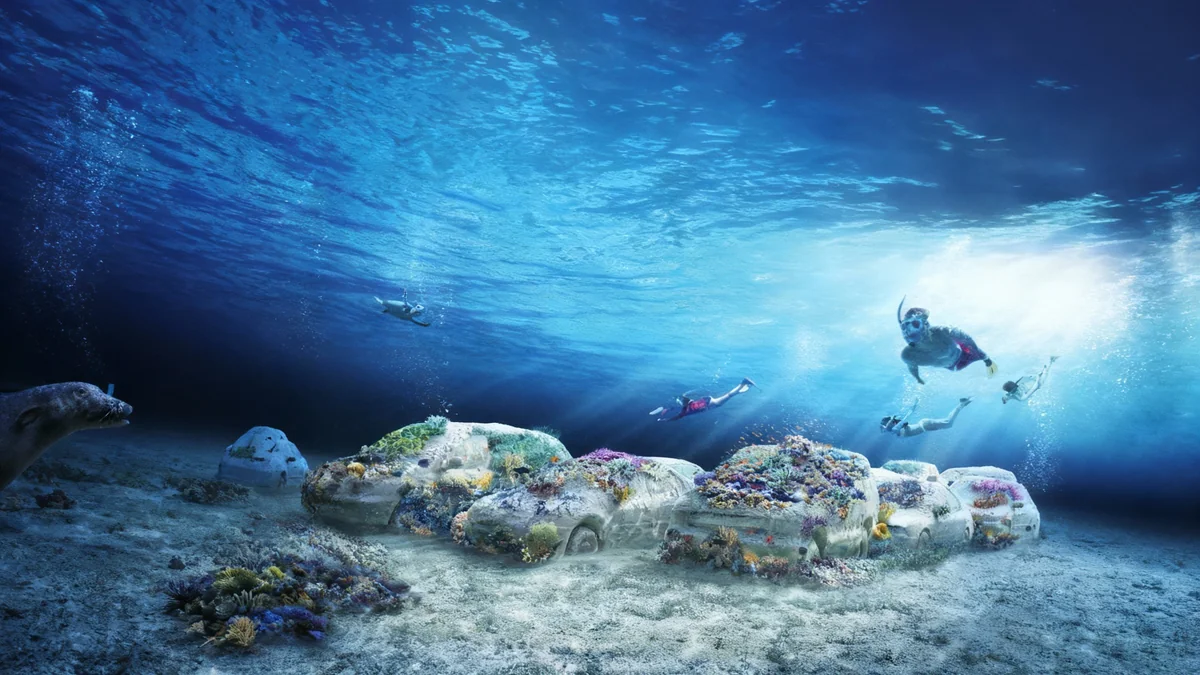Miami Beach has started construction on a massive, seven-mile-long artificial reef project. This initiative, known as "Reefline," combines environmental restoration with public art. It aims to revitalize the area's coral habitats and create a new underwater attraction accessible to swimmers and snorkelers directly from the beach.
The project will feature a series of marine-grade concrete sculptures, designed by international artists, which will eventually become living coral reefs. This unique blend of art and science is set to transform the offshore environment, offering a new destination for ecotourism and marine education.
Key Takeaways
- Reefline is a seven-mile artificial reef project off Miami Beach.
- It combines art installations with coral habitat restoration.
- The first phase involves 22 concrete cars by artist Leandro Ehrlich.
- The project is designed to be accessible to snorkelers and swimmers.
- Funding includes a $5 million bond from Miami Beach voters.
Art Meets Ecology Offshore
The Reefline project is not just an environmental endeavor; it is also a significant artistic undertaking. Curated by Ximena Caminos, known for her cultural placemaking work, the project features contributions from several internationally recognized artists. Their sculptures will form the foundation for new coral growth.
The first phase, already underway, showcases a unique installation by Argentinian artist Leandro Ehrlich. This initial phase involves placing 22 concrete cars on the ocean floor, arranged to resemble an underwater traffic jam. These structures are specifically designed to serve as ideal substrates for coral transplantation and growth.
"The cars…have the perfect morphology to plant corals," Caminos stated. "They're perfect flowerpots for corals."
Project Facts
- Length: 7 miles
- Depth: 15-20 feet
- Distance from Beach: Approximately 700 feet
- First Phase: 22 concrete cars by Leandro Ehrlich
- Estimated Completion: Over a decade
Cultivating New Life: The Coral Nursery
Central to the Reefline project is the work of marine biologist Colin Foord and his organization, Coral Morphologic. In a Miami warehouse, Foord oversees a thriving coral nursery, tending to over 2,000 tiny soft coral specimens. These corals, primarily gorgonians, are crucial to Caribbean and Floridian reef ecosystems.
Foord's lab cultivates various species, including sea fans and sea whips, some of which can grow up to six feet tall. These resilient corals, collected locally, are chosen for their ability to withstand disease and rising ocean temperatures. They will eventually be transplanted onto the concrete sculptures, transforming them into vibrant, living reefs.
Within a few years, the hope is that these underwater art installations will be completely covered by coral, creating a dynamic habitat for marine life. Ehrlich himself anticipates this transformation, noting that the cars will eventually disappear under the coral's growth, a process he finds "really fantastic."
Historical Context
Miami Beach once had a natural offshore coral reef that extended along its coast. However, by the 1970s, this natural reef was largely smothered by sand used to replenish the beach. Reefline aims to restore and recreate this lost marine habitat, bringing back a vital part of Miami Beach's natural heritage.
Accessibility and Education
One of Reefline's key features is its accessibility. Positioned in relatively shallow water, between 15 to 20 feet deep, and only about 700 feet off Miami Beach, the artificial reef will be easily reachable. This means anyone with a mask and fins can swim out to experience the underwater art and burgeoning coral ecosystems without needing a boat.
Beyond tourism, the project emphasizes education. Plans include an onshore marine learning center. This facility will inform visitors about the planet's endangered coral reefs, highlighting the importance of conservation and the role of projects like Reefline in marine restoration.
Caminos also envisions the coral-covered sculptures becoming visible from the air, offering a unique perspective to those flying into Miami. She believes one of the future installations, a constellation of 57 giant sculpted starfish, could even become a lasting symbol for the city.
- Accessible: Swimmers and snorkelers can reach it directly.
- Educational: Onshore marine learning center planned.
- Symbolic: Future installations may become city landmarks.
Funding and Future Vision
The Reefline project represents a significant investment in Miami Beach's environmental and cultural landscape. The city of Miami Beach has committed $5 million through a voter-approved bond. This funding demonstrates strong local support for the initiative.
Ximena Caminos is leading efforts to raise an additional $6 million to fully fund the project's initial phase. While the first installations are now underway, completing the entire seven-mile-long reef is expected to take at least a decade. The long-term vision is to create a vibrant, self-sustaining ecosystem that also serves as a world-class cultural attraction.
The project provides "public housing for fish," as Caminos playfully describes it, offering new homes where marine life can thrive. This innovative approach integrates art, science, and community engagement to address critical environmental challenges while enhancing the city's appeal.





